Chapter 5: Diversity and inclusion
Key points
- The proportion of employees reporting their agency is committed to creating a diverse workforce has increased.
- There is still room for improvement, with 65 per cent of APS employee census respondents agreeing that their SES manager actively supports people of diverse backgrounds.
- At 30 June 2018, 59 per cent of employees in the APS were women. This rate has remained reasonably stable over the past decade.
- Despite an overall increase in the proportion of Indigenous employees in the APS, representation by classification was heavily skewed towards the lower end.
- Of the APS employee census respondents in 2018, 8.7 per cent reported having an ongoing disability
- In the 2018 APS employee census, 4.4 per cent of respondents indicated they identified as LGBTI+.
A diverse workforce enables new ideas and different ways of thinking. Employees from a range of backgrounds bring different experiences and perspectives. This can be useful for problem solving in various situations, adding value to policy development and offering more tailored service delivery to the Australian public.
Actively encouraging diversity also opens the APS up to a bigger talent pool. An inclusive environment facilitates the attraction and retention of employees from diverse backgrounds.
The tendency of organisations to recruit, train and select for similarity … has become widely recognised … organisations become comprised of a very narrow range of skills, experience, background, values and styles of behaviour and work. This… tends to result in organisations that are unaware of the diversity of community needs and values and lacking in innovation. They are unable to carry out effectively policies for the whole community, to respond to change in the community and in the economic and political environment or to improve administrative practices through innovation.
Dr Peter Wilenski AC, former Chairman of the Public Service Board (1983–87)43
The OECD draft Recommendation on Public Service Leadership and Capability recommends that member countries build values-driven culture and leadership in the public service, centred on improving outcomes for society by ensuring an inclusive public service that reflects the diversity of the society it represents.44
Diversity is being invited to the party. Inclusion is being asked to dance.
Verna Myers, Diversity Advocate
The employment principles outlined in the Public Service Act provide that the APS is a career-based service that recognises the diversity of the Australian community and fosters diversity in the workplace.
Diversity within a workplace encompasses many differences, including cultural background, gender, age, sexual orientation and abilities. Connected to diversity is the concept of inclusion.
Workplace inclusion occurs when diversity is respected, connected and contributes to organisational success.45 Inclusion benefits all employees, not just those from identified diversity groups.
Leading diversity
The Secretaries Equality and Diversity Council, established in 2016, comprises all APS departmental secretaries. It also includes two external members—Dr Tom Calma AO and Ms Kathryn Fagg—who provide insights and experience from outside the APS.
The Council is committed to delivering an APS workplace culture that builds respect, fosters inclusiveness and promotes diversity. It has undertaken in-depth consideration of workplace experiences by hearing first-hand from APS employees who identify with specific diversity groups. A common theme that has emerged from these discussions is the need to continue building inclusive workplaces. The Council has also commissioned research into women in senior leadership and job-sharing arrangements in the APS. Research findings will be used to inform initiatives in support of the implementation of Balancing the Future: The Australian Public Service Gender Equality Strategy 2016–19 (Gender Equality Strategy).
The Council launched the APS Diversity and Gender Equality Awards in 2017 to recognise the outstanding contributions that agencies, employee networks and individual employees make towards fostering workplace diversity and inclusion. The awards attracted many high-quality nominations from across the APS.
The Council’s future work will focus on continuing to develop inclusive workplaces, talent programs supporting a pipeline of employees between APS 5 and EL 2, inclusive management for EL employees, and ongoing monitoring of the three current diversity strategies.
To support Indigenous employment and retention initiatives in the APS, an Indigenous SES Network was established. The Network offers cultural and strategic advice to the Secretaries Equality and Diversity Council.
Indigenous SES Network
The Indigenous SES Network brings together senior Aboriginal and Torres Strait Islander leaders from across the APS to drive meaningful change and provide guidance on issues impacting on the employment of Indigenous Australians in the public service. The Network is sponsored by the Australian Public Service Commissioner and advised by Professor Tom Calma. As Senior Indigenous public servants, network members provide a stewardship role for Indigenous employees. They actively advocate, role model and promote diversity within the APS and within their agencies.
The Network’s strategic objectives are driven by a smaller Steering Committee, supported by a working group of EL Indigenous employees.
In 2018, the Network has given considerable thought and attention to enhancing Indigenous leadership in the APS. They are progressing a strategy to work across agencies, with tangible actions designed to improve the attraction, retention and development of Indigenous leaders. Optimisation of Indigenous leadership will enhance the Government’s ability to understand and facilitate social and economic opportunities for Indigenous Australians and ensure policies and programs reflect Indigenous world views, needs and aspirations.
Recent years have seen an increase in the proportion of employees reporting they believe their agency is committed to creating a diverse workforce (Figure 25). In 2018, three-quarters of APS employee census respondents agreed their agency actively promotes and supports an inclusive workplace culture.
Figure 25: APS employee perceptions of agency commitment to creating a diverse workforce, 2013–18

Source: APS employee census
In the 2018 APS agency survey, agencies were asked to report how many SES officers in each agency were active champions for diversity and inclusion. Agencies reported an average of three SES in each agency, with 318 across the APS.
The one thing my agency is doing well is developing a respectful, inclusive work environment that encourages collaboration and fosters excellence.
EL 1, small specialist agency
The actions of senior leaders are important in developing and maintaining an inclusive workplace culture. Sixty-five per cent of employee census respondents agree that their SES manager actively supports people of diverse backgrounds. More work is needed in the APS to increase senior leadership support in creating a diverse and inclusive workforce.
The value of diversity is not just that it humanises us and helps us treat others with respect and value them for the people they are, but that it keeps us on our feet, brings in new and different ideas, ensures we have the best of the crop advising ministers and implementing government policy, and improves outcomes.
Dr Gordon de Brouwer PSM, Former Secretary, Department of the Environment and Energy, September 201746
Gender
At 30 June 2018, 59 per cent of the 150,594 employees in the APS were women (Figure 26). This rate has remained reasonably stable over the past decade.
Figure 26: APS gender representation by year, 2009–18
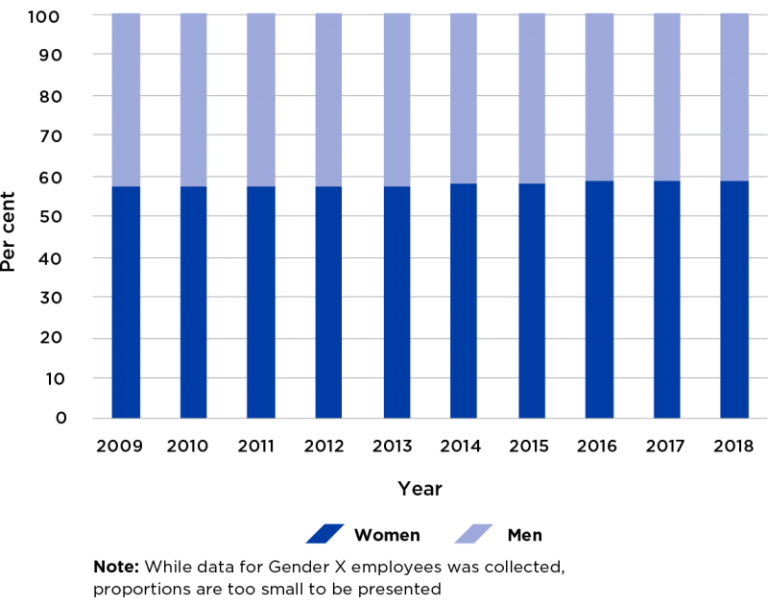
Source: APSED
Excluding trainees, there are more women than men at all classification levels up to and including EL 1. The proportion of women at EL 2 continues to increase (Figure 27).
The proportion of female SES employees increased substantially to 45 per cent in 2018, up from 36 per cent in 2009. In 2017–18, gender parity at secretary level was achieved for the first time.
I’d like to get to the point where gender really doesn’t matter in a public service career, where women and men are both judged really on their merits rather than on a gendered view of merit as I think happens even now.
Renée Leon PSM, Secretary, Department of Human Services47
Figure 27: Classification of APS employees by gender, 2018
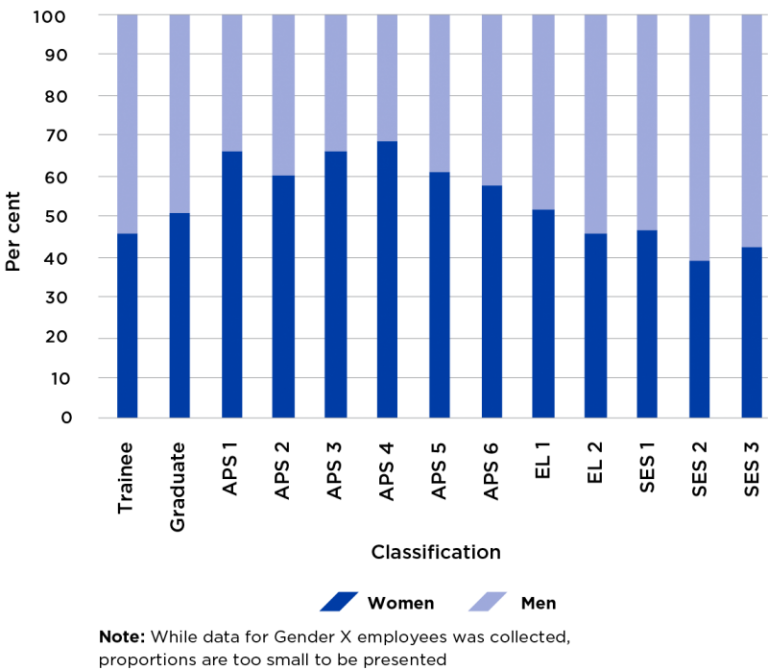
Source: APSED
Implementation of the APS Gender Equality Strategy
Balancing the Future: The Australian Public Service Gender Equality Strategy 2016–19 sets out actions for driving high performance and boosting productivity. The strategy’s key focus areas include:
- driving a supportive and enabling workplace culture
- achieving gender equality in APS leadership
- working innovatively to embed gender equality in employment practices
- increasing take-up of flexible work arrangements by men and women
- measuring and evaluating actions.
In the 2018 APS agency survey, agency responses indicate that progress is being made in implementing the Gender Equality Strategy.
The 2018 APS employee census data indicates that APS employees have a generally positive view of the actions their SES manager and immediate supervisors are taking to support gender equality.
Figure 28: APS employee perceptions of gender equality
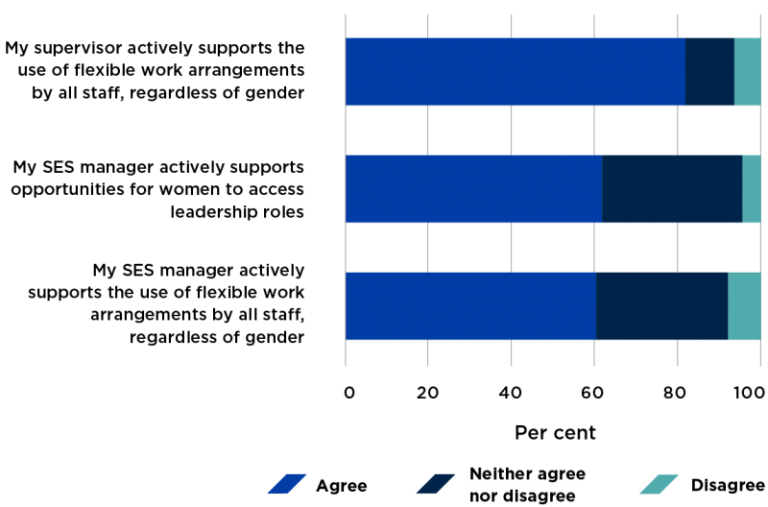
Source: 2018 APS employee census
The report Embedding Gender Equality in the Australian Public Service: Changing practices, changing cultures48 found that the Gender Equality Strategy has been influential in further progressing and embedding gender equality in the APS. Specifically, it has started an important conversation about the nature of equality, opening discussion around the opportunities and challenges in progressing gender equality. However, more work is needed if the APS is to remain a leader in gender equality in Australia.
In the 2018 APS agency survey, some of the most frequently reported initiatives to implementing the Gender Equality Strategy included developing and implementing agency-specific diversity strategies, having gender champions and gender networks, and changing recruitment practices. Some changes to recruitment practices included gender-specific recruitment targets and gender-balanced recruitment panels.
Agencies reported that barriers to implementing the initiatives in the Gender Equality Strategy include the low number of female applicants for some advertised positions and the belief by some managers that a focus on gender equality is inconsistent with merit-based recruitment.
Gender reporting
On 1 July 2016, the APSC began recording a third gender category in the APS Employment Database. This category encompasses APS employees who do not identify as male or female. For the purposes of APS data collection, this third gender category is referred to as ‘X’. This collection approach aligns with the Australian Government Guidelines on the Recognition of Sex and Gender49 which require non-binary gender identity to be reflected in government records.
Ninety per cent of agencies have reported they are promoting and applying the gender X category or similar in their HR systems and reporting. Work to enable this has included reconfiguring HR systems and updating recruitment and on-boarding forms. The APSC is working with agencies to support the upload of gender X data into HR systems so data captured accurately represents the gender identification of APS employees.
Gender X was first introduced as a gender category in the APS employee census in 2014. Census data collected between 2014 and 2017 showed reasonable stability in the rates of APS employees identifying as gender X (Figure 29).
In 2018, the rate of respondents identifying as gender X dropped considerably. This coincided with the introduction in 2018 of ‘prefer not to say’ as an option for the gender question. In previous years’ it was hypothesised that some census respondents selected gender X as a way to further anonymise their census responses. If this trend continues, this would suggest that the hypothesis was correct.
Figure 29: Representation of gender X employees in the APS, 2014–18
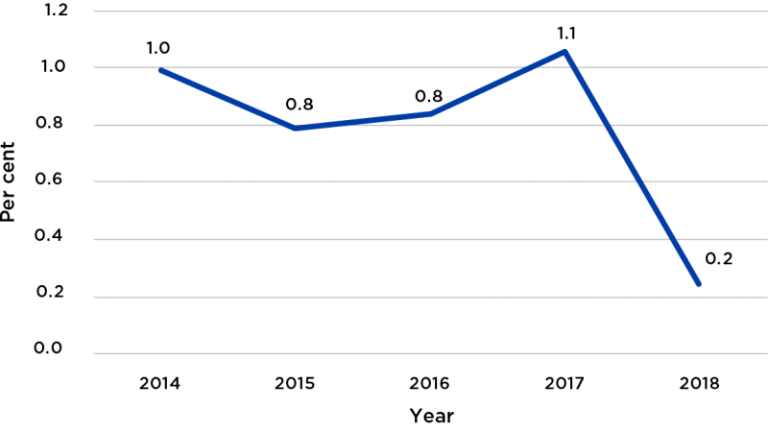
Source: APS employee census
Indigenous representation
At 30 June 2018, 3.3 per cent of the APS workforce identified as Indigenous (Figure 30). The representation of Indigenous employees in the APS has improved slightly over the last 10 years and is higher than the proportion of Indigenous Australians in the wider population (2.8 per cent).
Figure 30: Representation of Indigenous employees in the APS, 2009–18
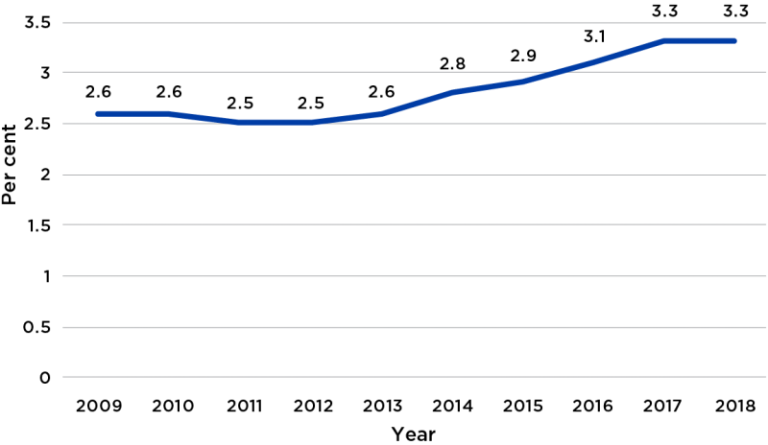
Source: APSED
Despite an overall increase in the proportion of Indigenous employees in the APS, representation by classification is heavily skewed towards the lower end (Figure 31).
Indigenous employees in the APS are most commonly employed at the APS 4 level (27 per cent). Representation at more senior levels is very low, with only 0.05 per cent of all SES Indigenous employees.
Figure 31: Representation of Indigenous and non-Indigenous APS employees by classification, 2018
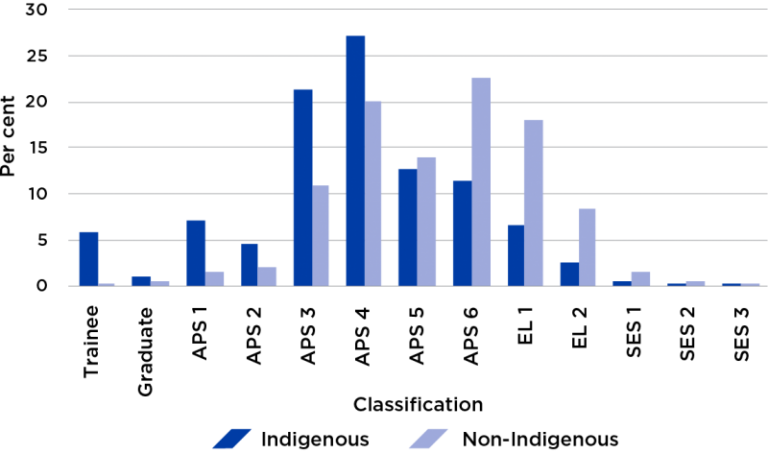
Source: APSED
In response to the Forrest Review: Creating Parity50, the Government released the Commonwealth Aboriginal and Torres Strait Islander Employment Strategy 2015–1851 in September 2015. The strategy addresses the priority to build Indigenous employment within the Commonwealth public sector. Specific goals include:
- increasing the representation of Indigenous employees across the Commonwealth public sector to 3 per cent by 2018
- ensuring Indigenous Australians are offered entry pathways into the public service
- creating better career development opportunities for Indigenous employees
- increasing the representation of Indigenous Australians in senior leadership positions.
All Commonwealth agencies have an Indigenous representation target, either a self-nominated stretch target or the minimum 2.5 per cent. In the 2018 APS agency survey, 69 per cent of agencies reported having set an agency-specific target.
To support the retention and career advancement of Indigenous employees, a range of whole-of-APS retention and development programs are underway. These include:
- Indigenous mentoring program: More than 150 mentoring partnerships were established in 2017. Following the success of the first pilot, a second pilot is underway.
- excELerate: A career development program that combines formal training and individualised coaching. The program supports the progression of high-performing Indigenous employees at APS 5 to APS 6 levels into EL roles.
Australian Government Indigenous Lateral Entry pilot
The APSC’s Australian Government Indigenous Lateral Entry (AGILE) pilot is designed to improve representation of Indigenous employees at EL and SES levels. AGILE is a centrally co-ordinated recruitment process using the affirmative measure.
The key aim was to attract experienced Indigenous professionals. The pilot recruited Indigenous employees to four in-demand capability areas: project management; strategic policy; law; and accounting and finance. It also provided career advancement opportunities for existing Indigenous APS employees.
Applications were received from 220 individuals, with 67 found suitable for roles at APS 6 to EL 2 classifications. APS agencies can engage successful AGILE candidates to fill immediate vacancies, and can recruit from Indigenous talent merit pools for up to 12 months. Initial indications are positive, with several candidates having already accepted offers of employment. A comprehensive evaluation of the pilot is expected to be completed by the end of 2018.
Agencies continue to implement the strategy within their own contexts. In the 2018 APS agency survey, the most frequently reported initiatives for increasing Indigenous employee representation, include: apprenticeship, internship and cadet programs; advertising vacancies in alternative places such as the Koori Mail and ‘Our Mob’ job board52; and offering scholarships, study assistance, further training and mentoring programs.
Challenges agencies experienced to expanding Indigenous employment opportunities and increasing the representation of Indigenous employees in senior roles include a limited number of Indigenous candidates applying for vacancies and low turnover rates in their senior roles.
A progress report on the strategy53 was published in May 2018. The report outlines areas of future focus to further improve employment outcomes and opportunities available to Indigenous peoples. Although the strategy has had a positive impact on increasing employment opportunities for Indigenous persons, considerably more effort is required.
A full evaluation of the Commonwealth Aboriginal and Torres Strait Islander Employment Strategy will be undertaken at the completion of the strategy.
Lesbian, Gay, Bisexual, Trans and/or Intersex representation
The APS employee census collected data on employees who identify as LGBTI+ for the first time in 2017. In the 2018 employee census, 4.4 per cent of respondents indicated they identified as LGBTI+. This was a slightly higher proportion than 2017 (4.1 per cent).
Analysis of the measures in the census showed very similar workplace perceptions reported by respondents who identified as LGBTI+ and those who did not. This included wellbeing, job satisfaction, engagement, and perceptions of inclusivity in the workplace.
2017 APS Diversity and Gender Equality Awards – Network Award
Winner: ATO Making Inclusion Count (ATOMIC) – The Australian Taxation Office’s LGBTI+ employee network
The Australian Taxation Office launched its LGBTI+ and ally network, known as ATOMIC, in 2016. The network now has more than 1,700 members and is one of the leading LGBTI+ networks in the APS. ATOMIC is passionate about creating an environment where everyone can ‘bring their whole self’ to work. It achieves this through initiatives such as hosting monthly ATOMIC happy hours in Canberra to connect APS agencies, speaking about LGBTI+ inclusion at the Australian Government Leadership Network, appointing SES Champions to promote the inclusion message and provide executive support, and celebrating days of importance to the LGBTI+ community.
Disability
Data on employees with disability is collected through agency HR systems and the annual APS employee census.
Of the census respondents in 2018, 8.7 per cent of employees reported having an ongoing disability (Figure 32). This proportion is higher than the 3.7 per cent recorded on agency HR systems as identifying as an employee with disability.
This difference in rates has been consistently reported over many years and could be the result of a number of issues. Disability is not necessarily static. Employees who acquire disability during their career may not update their HR record. In some cases, employees may be concerned about including their disability in their agency’s HR system but may be comfortable including that information in a confidential survey.
Figure 32: Representation of employees with an ongoing disability in the APS, 2012–18
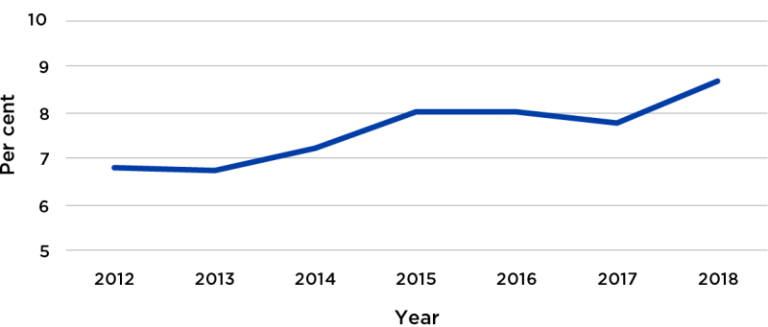
Source: APS employee census
The APS is committed to supporting employees with disability. In May 2016, the As One: Making it Happen— APS Disability Employment Strategy 2016–1954 was launched. This was developed in consultation with employees with disability, APS agencies and peak disability bodies. It focuses on four key action areas which all include a focus on Indigenous people with disability:
- expand the range of employment opportunities for people with disability
- invest in developing the capability of employees with disability
- increase the representation of employees with disability in senior roles
- foster inclusive cultures in the workplace.
As further commitment to the recruitment of people with disability, the APSC launched GradAccess in 2017. GradAccess is a two-year pilot of centrally co-ordinated graduate recruitment process for people with disability. In the first year, 23 people with disability were offered a place in 2018 APS graduate programs. The second year is underway for places in the 2019 APS graduate programs.
In 2018, the APSC expanded the entry level pathways for people with disability by implementing a second two-year pilot, NextStep. This is a cross-agency traineeship for people with disability managed through a centrally co-ordinated recruitment process. Four agencies are participating in the NextStep pilot with 16 placements available.
2017 APS Diversity and Gender Equality Awards – Department/Agency Award
Winner: National Disability Insurance Agency
The National Disability Insurance Agency (NDIA) is striving to be an employer of choice for people with disability, with a target of 15 per cent. This target is within reach, with 13 per cent of NDIA’s current workforce identifying as having disability. The NDIA continues to develop and implement policies to attract, select, support, and retain employees with disability. It is leading the way in the recruitment and employment of employees with disability and role models how practices increasing access to employment opportunities for people with disability can become business-as-usual. Candidates and employees are supported throughout the recruitment process. Successful candidates are then further supported by Disability Liaison Officers from the Inclusion and Diversity Support Unit to ensure adjustments are in place for a safe, inclusive and accessible work environment that allows every individual to perform at their best.
Source: 2018 APS employee census
Older workers
The APS workforce is ageing. In the last 10 years, the mean age of APS employees has increased from 41.4 years to 43.4 years (Figure 33).
Figure 33: Mean age of APS employees, 2009–18
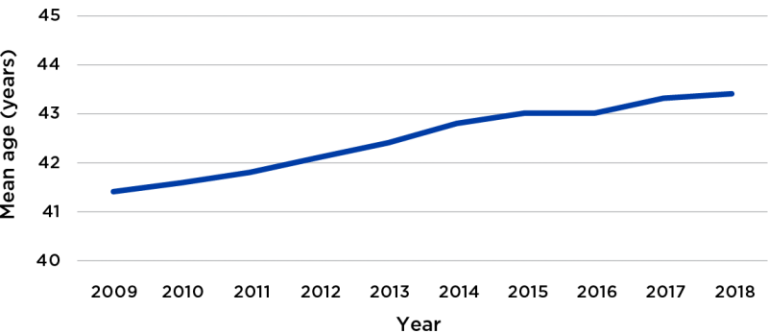
Source: APSED
The APS must give due consideration to its ageing workforce. It needs to develop workforce plans and other age-related strategies to maximise the benefits of older workers and limit negative impacts, such as loss of corporate knowledge, because of retirement. In the 2018 APS agency survey, only 11 per cent of agencies reported having multigenerational and/or specific age group plans or strategies.
Responses to the 2018 APS employee census indicate that older workers, defined here as those 50 years of age or older, are the age group most likely to want to stay working for their agency for at least the next three years.
Figure 34: APS employee career intentions by age group
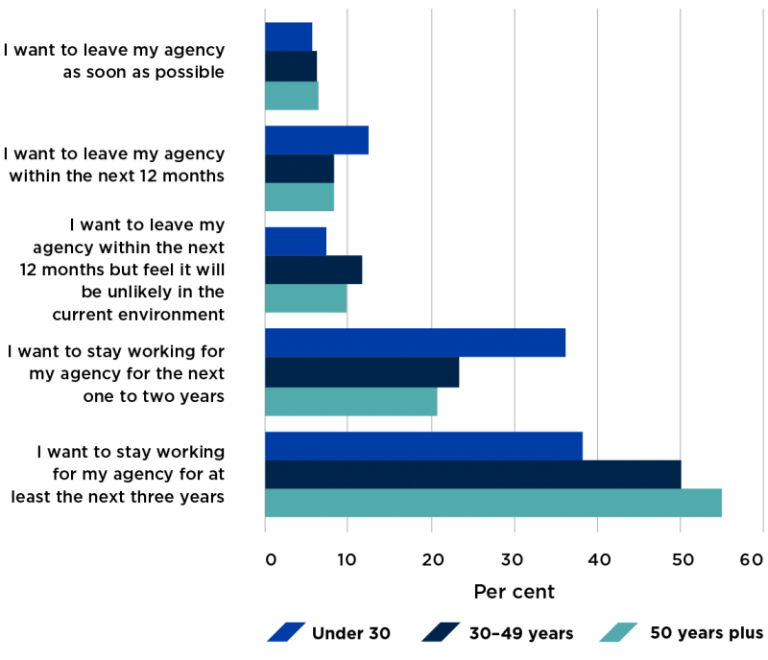
Source: 2018 APS employee census
Older workers are significantly less likely to consider leaving the APS for other employment opportunities (Figure 35). While younger respondents were most likely to consider leaving the APS for other job opportunities, the possibility that their current pay and conditions would not be met prevents them from doing so. Respondents 50 years of age and older reported that the impact on superannuation, or the fact that they were nearing retirement, is stopping them from seeking these job opportunities.
Figure 35: APS employee interest in leaving the APS for other job opportunities by age group

Source: 2018 APS employee census
Results from the 2018 APS employee census show that most respondents of all age groups felt committed to their agency’s goals and believed strongly in the purpose and objective of the APS. Some differences exist across age groups with satisfaction rates relating to rewards and recognition. Respondents under 30 years of age were most likely to agree they were fairly remunerated, and more satisfied with their non-monetary employment conditions, than were older age groups. They were also more likely to be satisfied with their job stability and security.
The Government announced the establishment of the Collaborative Partnership on Mature Age Employment in the 2018–19 Budget. This partnership includes representatives from business peak bodies, industry associations and mature-age advocacy groups. Its key priority areas are:
- Employer mobilisation—drive the recruitment and retention of mature-age Australians through influencing the policies and practices of employers and HR professionals.
- Industry awareness—promote the benefits of hiring and retaining mature-age workers, as well as the assistance and resources available, to employers, HR professionals, peak bodies and employment service providers.
- Workplace age discrimination—assist Australian firms to identify and address age discrimination in the workplace.
- Current and potential innovations—encourage business to hire older people, including those who have retired, using flexible work arrangements and other evidence-based measures.
As the central policy agency with responsibility for APS employment, the APSC is involved in this partnership to engage with other sectors about best practice to implement measures in the APS to drive the recruitment and retention of mature-age workers and to share experiences with them.
Cultural and linguistic diversity
Through agency HR systems, the APS collects information on employees from non-English speaking backgrounds (NESB). In 2017–18, 22 per cent of APS employees identified as being born overseas and 19 per cent identified as being from NESB (Figure 36). These proportions have continued a steady increase over the last 50 years.
Figure 36: Proportion of APS employees from non-English speaking backgrounds and APS employees born overseas, 1968–2018
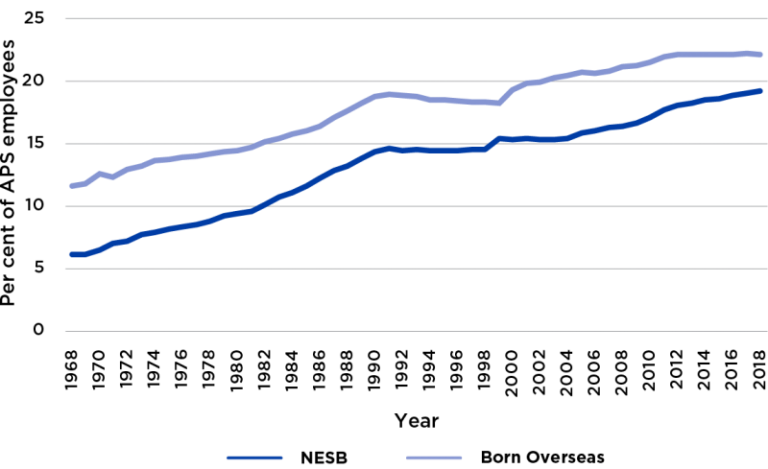
Source: APSED
In 1968, 87 per cent of APS employees born overseas came from Europe (Figure 37). This decreased steadily to 32 per cent in 2018, mainly because of an increase in employees from Asia. In 2010, employees with an Asian country of birth replaced employees from Europe as the highest group of people born overseas.
Figure 37: Proportion of APS employees by location of birth, 1968–2018
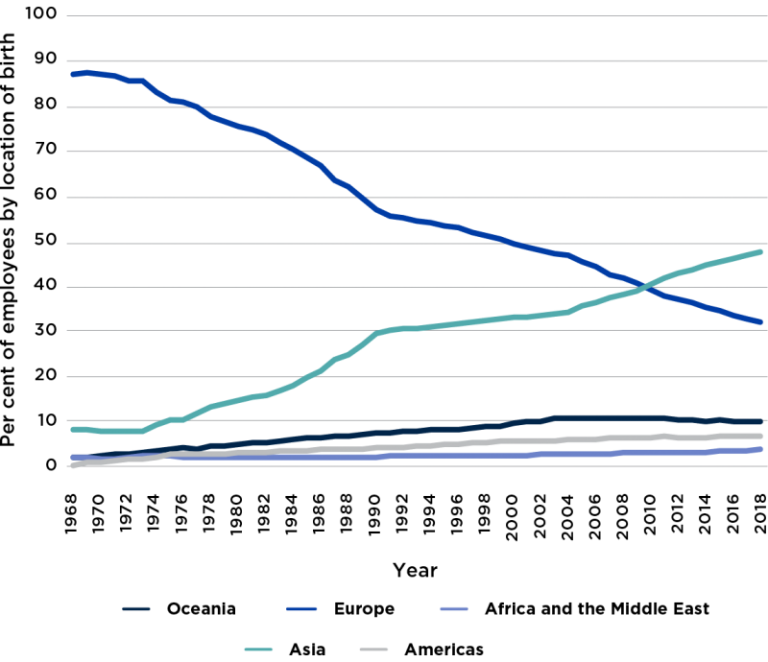
Source: APSED
NESB data has been collected through the annual APS employee census since 2012. However, in 2018 it was recognised that information about the cultural and linguistic differences of APS employees, was a more valuable measure for understanding employee perceptions. As a result, the 2018 APS employee census captured information on the cultural and linguistic diversity of respondents. The census contained questions consistent with the core elements of the ABS Standards for Statistics on Cultural and Language Diversity. Questions included country of birth, language other than English spoken at home, proficiency in spoken English and Indigenous status.
Cultural and linguistic diversity groups comprise a significant proportion of Australia’s population. Twenty-six per cent of Australians were born overseas and 21 per cent of Australians speak a language other than English at home. In comparison, a slightly lower proportion of respondents to the 2018 APS employee census (22 per cent) reported being born overseas and 18 per cent reported speaking a language other than English at home. Almost all respondents (99.6 per cent) reported the ability to speak English well or very well.
Considerations for the future
The level of diversity in the APS is slowly increasing, however it can be improved. The Government’s announcement on the development of an APS workforce strategy notes that improving the capability, capacity and diversity of the workforce is a key outcome.
Increasing the diversity of the workforce is important for the APS to most effectively serve a diverse Australian community. However, this will not be achieved in an enduring, meaningful way without simultaneously developing more inclusive APS workplaces. The APSC and the Secretaries Equality and Diversity Council are focused on providing leadership and support for agencies to embed inclusion in their workplaces.
43 Speech to the Federation of Australian University Staff Associations’ Conference on ‘Women in Post Secondary Education: Issues and Strategies 1975–1995’, 30 March 1985, Sydney.
44 OECD, Draft Recommendations of the Council on Public Service Leadership and Capability, http://www.oecd.org/gov/pem/draft-recommendation-of-the-council-on-publ… (accessed 15 October 2018).
45 O’Leary, J and Legg, A, Diversity Council Australia, DCA-Suncorp Inclusion@Work Index 2017–2018: Mapping the State of Inclusion in the Australian Workforce, Sydney, Diversity Council Australia, 2017.
46 IPAA Secretary Series: Secretary Valedictory, 7 September 2017.
47 Speech for International Women’s Day, 8 March 2018.
48 Williamson, S and Foley M (2017), Embedding Gender Equality in the Australian Public Service: changing practices, changing cultures, UNSW School of Business, https://www.unsw.adfa.edu.au/school-of-business/sites/bus/files/uploads… (accessed 14 October 2018).
49 https://www.ag.gov.au/rights-and-protections/publications/australian-go… (accessed 16 October 2018).
50 The Forrest Review, Creating Parity, (accessed 13 September 2021).
51 APSC, Commonwealth Aboriginal and Torres Strait Islander Employment Strategy,
http://www.apsc.gov.au/publications-and-media/current-publications/comm… (accessed 15 October 2018).
52 ourmob.com.au, Job Search, http://ourmob.net/ (accessed 15 October 2018).
53 APSC, Commonwealth Aboriginal and Torres Strait Islander Employment Strategy (accessed 15 October 2018).
54 APSC, http://www.apsc.gov.au/managing-in-the-aps/disability/as-one-aps-disabi… (accessed 15 October 2018).



